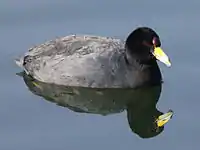Andean coot
The Andean coot (Fulica ardesiaca), also known as the slate-coloured coot, is a species of bird in the family Rallidae. It is found in the Andes from far southwestern Colombia to northwestern Argentina. Its natural habitats are swamps and freshwater lakes. Fossils tentatively assigned to this species are known from the Laguna de Tagua Tagua formation of Chile.[2]
| Andean coot | |
|---|---|
 | |
| at Otavalo, Ecuador | |
| Scientific classification | |
| Kingdom: | Animalia |
| Phylum: | Chordata |
| Class: | Aves |
| Order: | Gruiformes |
| Family: | Rallidae |
| Genus: | Fulica |
| Species: | F. ardesiaca |
| Binomial name | |
| Fulica ardesiaca Tschudi, 1843 | |
Description
The bill and shield color are variable. The most common combination is a chestnut shield and yellow bill with a black spot on it. Other combinations are yellow shield / white bill and white shield / white bill.
Physiology
The Andean coot is found in both North and South America.[3] As they are found at a wide range of different altitudes, the populations that live at high altitudes have adapted physiologically to a low-oxygen environment. For example, Andean coots living at altitude have more capillaries per square millimeter of muscle compared to Andean coots living at sea level.
Gallery


 Illustration by Joseph Smit, 1869
Illustration by Joseph Smit, 1869
References
- BirdLife International (2012). "Fulica ardesiaca". IUCN Red List of Threatened Species. 2012. Retrieved 26 November 2013.
- Alarcón-Muñoz, Jhonatan; Labarca, Rafael; Soto-Acuña, Sergio (2020-12-01). "The late Pleistocene-early Holocene rails (Gruiformes: Rallidae) of Laguna de Tagua Tagua Formation, central Chile, with the description of a new extinct giant coot". Journal of South American Earth Sciences. 104: 102839. doi:10.1016/j.jsames.2020.102839. ISSN 0895-9811.
- León-Velarde, F.; Sanchez, J.; Bigard, A. X.; Brunet, A.; Lesty, C.; Monge-C, C. (February 1993). "High altitude tissue adaptation in Andean coots: capillarity, fibre area, fibre type and enzymatic activities of skeletal muscle". Journal of Comparative Physiology B. 163 (1): 52–58. doi:10.1007/BF00309665. ISSN 0174-1578. PMID 8459054. S2CID 24202102.

